Common Contract Issues in Business
Last updated: October 10, 2023
Hear that? That's the sound of exasperated sighs over legal issues that affect negotiations and contracts. These issues strike businesses of all shapes and sizes, leaving procurement, sourcing and purchasing managers and business owners everywhere frustrated and wondering if a mutually beneficial buyer-supplier contract is a myth, not a reality.
What are common issues affecting the contracting process that seem to haunt enterprises — and what can you do about them? We're reviewing today's top contracting problems, then exploring the legal, operational and negotiation tools at your disposal to draft and manage vendor contracts that truly benefit all parties — and finally silence that symphony of sighs.
Why It's Important to Reevaluate Your Contracts
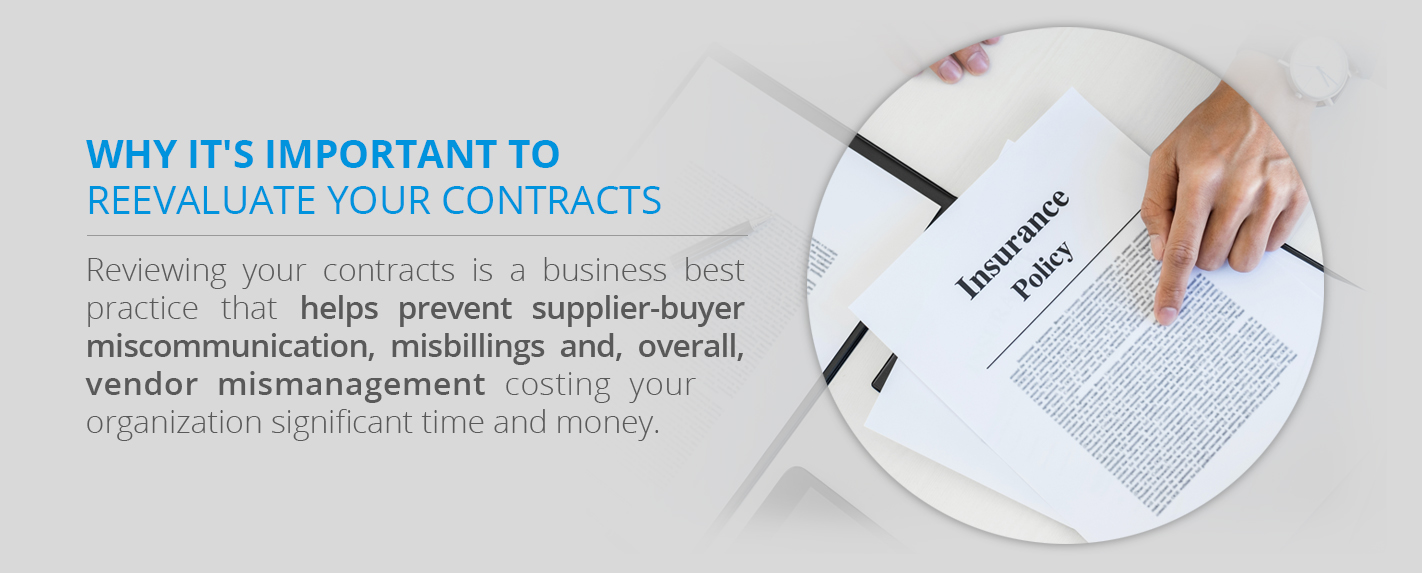
Reviewing your contracts is a business best practice that helps prevent supplier-buyer miscommunication, misbillings and vendor mismanagement, costing your organization significant time and money.
Still, far too few organizations support routine contract reviews. The handful that do tend to opt for internal audits, handing off annual or biannual contract analyses to already overburdened procurement staff or the heads of departments to lump in with other domain reviews.
This practice may saddle an already thinly stretched staff and create potential conflicts of interest. Depending on the industry, it can even introduce potential compliance concerns.
An organization manages these risks by partnering with an external professional contract negotiation firm that — at a minimum — provides current contract reviews and inspects upcoming contract drafts in the organization's preemptive interest.
These outsourced contract negotiation firms can:
- Perform in-depth contract draft and proposal assessments
- Examine terms and conditions of current and prospective contracts
- Mediate conflict resolution between buyers and suppliers
- Provide wider marketplace comparisons for your direct and indirect spend considerations
- And more, based on your exact contract servicing needs
Contract Issues That Affect Negotiations
Today's common contractual issues can occur at many points in the procurement cycle. That means before, during or after signing a supplier agreement, with problems tucked into the details of contract terms or discovered across various touchpoints and service interactions with your vendor.
Regardless of the situation, the outcome is the same — contract issues in businesses today come down to mismanaged expectations. Buyers and suppliers must find middle-ground solutions that remedy any problems before they happen. If they fail to do so, the contract issues illustrated below are bound to repeat themselves.
1. Pricing

Pricing is the first major contract obstacle businesses cite when securing or reviewing their procurement contracts. Generally speaking, these contract pricing problems can be broken down into two categories:
- Unmanaged procurement spend: When businesses have little to no standardized control or contracts in place related to buying production-related, overhead-related or general supplies.
- Mismanaged procurement spend: When businesses have standardized processes and contracts in place instructing how, when and where to buy supplies from, but these processes are frequently adapted, ignored or, upon inspection, incongruent with the business' best financial interests.
Let's break both types of contract pricing obstacles down further, illustrating how each affects the overall procurement practices of a business.
Unmanaged Procurement Spend
Unmanaged spend occurs when an organization doesn't have an institutionalized process for sourcing and purchasing direct and indirect supplies.
This is a particularly pressing issue for businesses that operate with decentralized purchasing teams. Disparate offices and facilities are left on their own to buy supplies in an ad-hoc manner with no formal list of approved suppliers to purchase from. Confusion abounds, exacerbated by a ballooning list of vendors, unwieldy spend budgets and the loss of any opportunity for competitive sourcing, bulk discounts and vendor partnership credits.
Mismanaged Procurement Spend
While your business may have standardized supplier contracts — even a consolidated set of ones — those contracts may no longer serve your company's bottom lines. Upon further review, you may even find current procurement contracts contain some of the following issues:
- Lack of a pricing middle ground: Buyers and suppliers may be unable to reach an agreement over contract pricing terms. This lack of a middle ground can quickly snowball into a stalled procurement cycle as well as a disaccord between a company and a vendor.
- Pricing discrepancies: A contract is rarely a single document produced by a single individual. It can contain many materials and iterations, including main terms and conditions, defined terms and conditions, appendices and clauses, schedules and delivery timetables and payment documentation — not to mention the actual purchase orders and invoices that will result once a contract is set in motion. It is not unheard of for pricing discrepancies to exist somewhere along the contract's life cycle, leading to multiple problems in the financial planning and analysis (FP&A) department.
- Price hikes: Whether sudden or planned, increased pricing for the same level of supplies or services is a red flag to buyers and a major source of contract disagreements.
- Tail spend: This is out-of-contract spending initiated by a small team or employee, typically via a purchasing card and in a one-off fashion. While tail spend costs and rates can vary, their impact can conflict with the entire purpose of vendor spend management and disrupt a procurement ecosystem.
All of these pricing issues end up costing an organization hard-earned money. Pricing disagreements and mismanagement hinder an already pressured procurement staff from proving their value to the broader organization in times of increased spend scrutiny, outsourcing and automation.
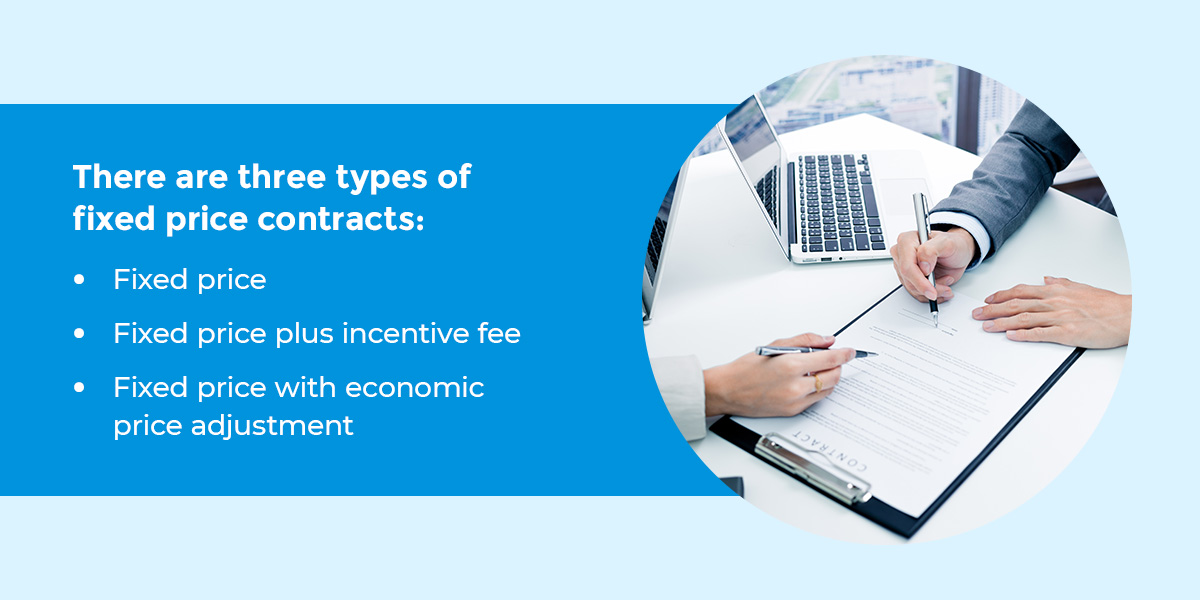
Fixed Price Contracts
The type of pricing-focused contract must be clear to avoid potential discrepancies later on. Fixed price contracts are sometimes misunderstood because certain requirements must be met for a transaction to occur.
For example, for Company A to receive the best pricing on a product or service, it must order X amount as a minimum requirement. Anything less than this stipulated order amount will not comply with the binding agreement. This could have an adverse impact on the procurement cycle at any point when one party feels they are at a disadvantage.
There are three types of fixed price contracts:
- Fixed price: The seller supplies the buyer with goods at a fixed, specialized rate, only if the buyer orders a minimum amount. The seller has the right to forfeit the set price if the buyer orders less than the required amount.
- Fixed price plus incentive fee: The buyer is in need of the goods supplied by the seller and is willing to order the minimum amount in addition to offering an incentive if the seller delivers their service above and beyond the requirements. If the seller delivers as promised, but the buyer does not meet its end of the bargain by paying an incentive fee, it could cause issues between both parties.
- Fixed price with economic price adjustment: Inflation impacts the seller's supply costs, leading to a price adjustment on orders. Unlike an unpredictable price hike, the contract specifies that with any change in the economic environment, the seller can rightfully charge more for goods and services within reason. The adjustment makes a provision to cover the seller's profit margin and may not be inflated beyond this. The buyer fully understands and agrees to the possibility of this increase and takes this into account when budgeting for the required goods the seller supplies.
2. Conditions
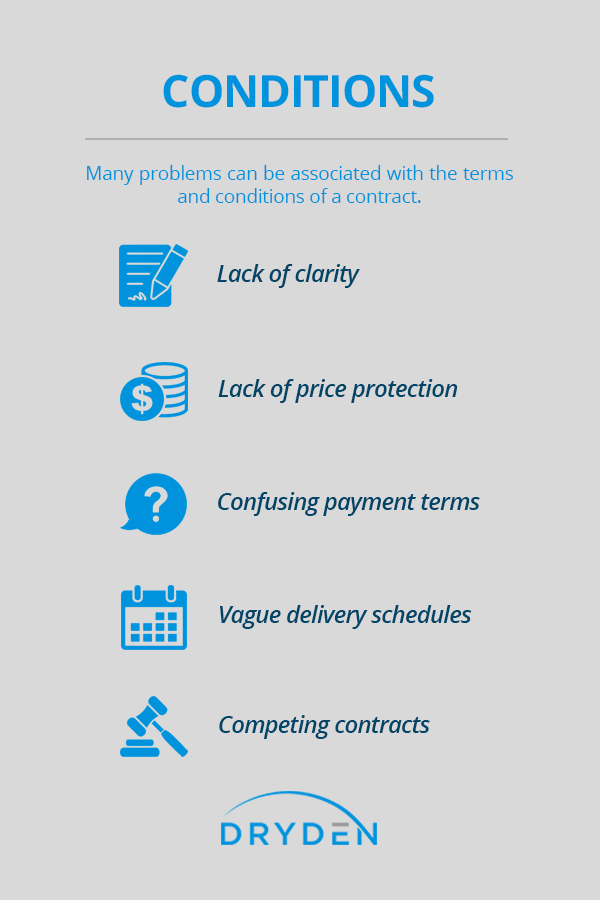
Terms and conditions are the backbones of a procurement contract.
This section of the contract states the legal boundaries agreed upon between the buyer and supplier. In other words, it details the rights and responsibilities of both parties. If a party is found to have violated any of those rights and responsibilities, the contract itself can be forfeited.
Many problems can be associated with the terms and conditions of a contract. From the legal to the linguistic, these problems can be difficult to spot by the untrained eye — or anyone outside of contract law:
- Lack of clarity: Vague or overly complicated terms and conditions can muddle the very contract responsibilities they're trying to assert. Any organization is put in a difficult position when it can't even understand what is required of them — much less what is required of the other party the agreement depends upon. Common contract clarity issues can include a lack of contract scope, payment processes, delivery schedules, term penalties and compliance boundaries.
- Lack of price protection: Businesses may experience unexpected price hikes, only to find their contracts contain no price protection terms or clauses. They're left paying rates that don't align with their financial capabilities yet aren't in a position to make any real changes.
- Confusing payment terms: Payment terminology can be unclear - for example, do you know the difference between "pay-if-paid" versus "pay-when-paid" off the top of your head? Depending on their place in a contract, these payment terms can have vastly different meanings, which can spell trouble when these or other such terms are misunderstood.
- Vague delivery schedules: Broad or imprecise service and delivery deadlines are a common bane to many new service contracts. When unaddressed, they can quickly escalate into enforcement provisions adding more work and more stress for procurement personnel, all because dates weren't clearly finalized from the contract's onset.
- Competing contracts: Decentralized procurement practices can put a business at risk for breaking competition clauses built into certain types of contracts. Departments managing their service contracts contribute to bloated vendor networks and are often oblivious to this breach risk.
To complicate matters further, many of the above conditional issues can occur across the different phases that make up the contract negotiation process:
- Before: Before the completion of any official contract, your organization may encounter problems such as extended negotiations, pricing disagreements, deliverable disagreements, enforcement provisions and penalty disputes — in addition, a "too many cooks in the kitchen" effect can occur, with multiple people editing documents at various times and obfuscating overall contract clarity.
- During: Contract drafts tend to pass through multiple hands for approval. This occurs on both the supplier and buyer sides, resulting in longer procurement lead times, pricing variability and last-minute contract alterations that may upset one party while favoring another.
- After: Unfortunately, contract problems can crop up even post-award. Many assume the work is done once their signature goes on the official contract documents. Yet buyers and suppliers must still navigate a contract's goods or service invoicing, deliveries, distribution and payments, all of which should have terms clearly and transparent in the contract.
To safeguard against conditional contract errors, some organizations include an "order of preference" clause to categorize and clarify roles and responsibilities. This clause creates a terms "hierarchy" of sorts, with the contract's provisions essentially ranked in order of importance to minimize confusion and settle disagreements before they happen.
3. Compliance
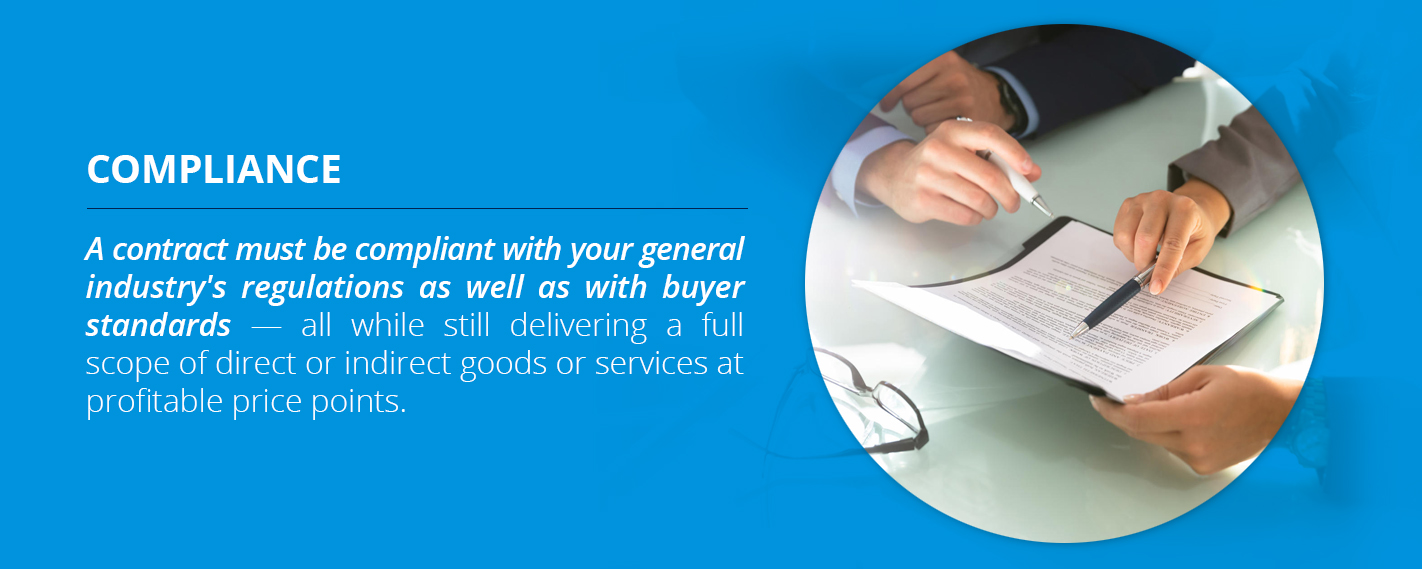
A contract must comply with your general industry's regulations and buyer standards — all while still delivering a full scope of direct or indirect goods or services at profitable price points.
Ensuring this compliance is a delicate and challenging balancing act, one that takes deep regulatory knowledge to manage. For their own peace of mind, many organizations enlist contract negotiation and procurement services to review their contract proposals in terms of relevant regulations.
Specific contract compliance concerns will vary depending on the industry you're in. However, a few contract compliance concerns thread across business fields:
- Cybersecurity: Outlining safe, secure network exchanges is integral to any procurement contract. To do so, parties make agreements regarding the access and usage of certain digital assets, in many cases including sensitive information like customer bank accounts, credit cards, contact information and even Social Security or tax data. The parties also agree to protect that confidential information using contemporary cybersecurity methods while data is in transit and after it is housed within suppliers' IT ecosystem endpoints.
- Technology transfer: Similar to cybersecurity compliance, technology transfers need to be outlined when a buyer, a supplier or both require access to each other's proprietary software — or any other relevant piece of technology — to conduct business.
- Intellectual property: Contracts must clearly spell out proprietary claims to any designs, works, products or ideas. This ensures sole recognition — and any related financial returns on it — is indisputably the legal right of only one party, not both.
- Noncompliant service deals and referrals: In certain contract arrangements, laws exist barring one party from recommending an add-on service or deal in which it might have vested financial interests. This is most common in fields like finance and healthcare, where professionals cannot make or recommend certain contract dealings from which they themselves could make more money.
- Buyer standards: Your organization may wish to include a set of statutes or expectations detailing the quality of the products or services provided by suppliers. This protects your company's production interests and provides transparency about the levels of goods you expect to receive.
4. Supplier Service Obligations
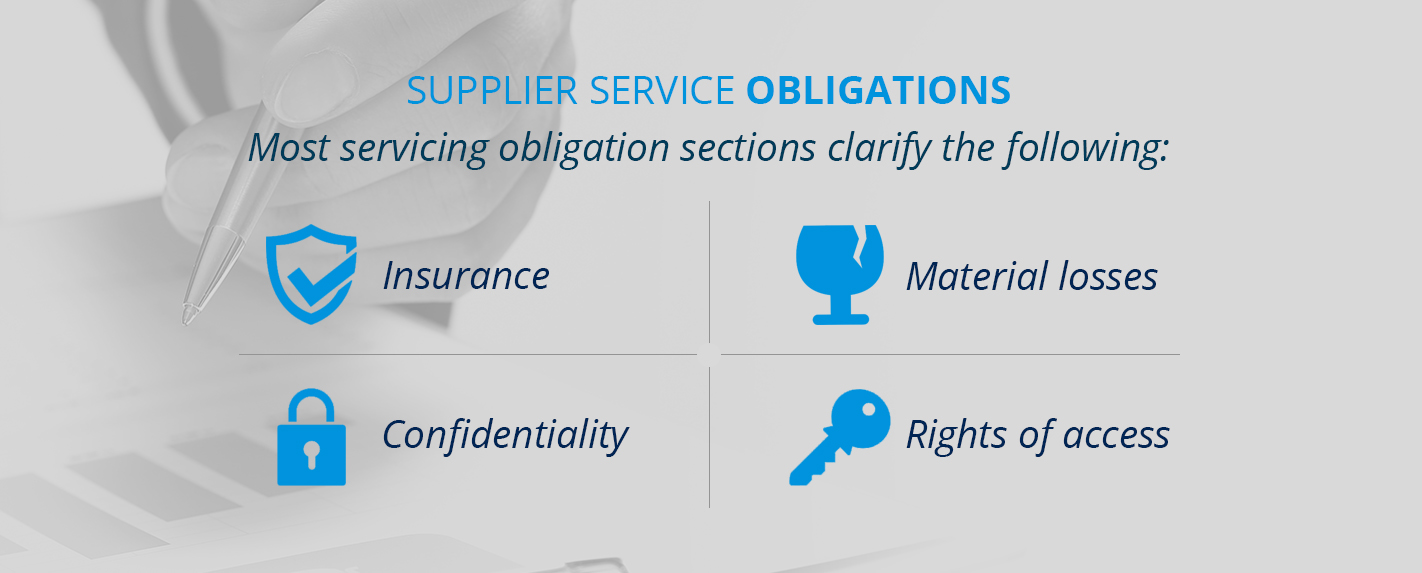
Another common issue experienced during the contract management process is the need to clarify the exact roles and expectations you desire from your supplier.
Whether procuring physical goods or ordering a set of services, you'll want an agreement on roles and expectations stated in clear writing, with the supplier acknowledging and agreeing to the full scope of identified obligations and related clauses. The agreement should use standardized terms and clear contract formats as much as possible. Most servicing obligation sections clarify the following:
- Insurance: Suppliers should be ready to support buyers with any relevant information and assistance if buyers must take on additional insurance related to the new contract. This insurance comes at no cost to the supplier, yet the supplier is likely an essential asset in its procurement. For example, a supplier's involvement is necessary to state to a buyer's insurance carrier the full replacement value of damaged or stolen materials, tools or equipment in the event such replacement reimbursements are filed. And if such values change, it is also the supplier's duty to update the buyer and their insurance carriers.
- Material losses: Contracts should detail the depth to which a supplier must conform to protocols and expectations laid out by insurance carriers in the event of material loss. Contracts should also state in which scenarios a supplier may bear the legal responsibility for that material loss, such as cases where the supplier was found to have grossly or negligently mispacked items, leading to their damage during transportation.
- Confidentiality: Certain business cases may require the buyer to ask the supplier for confidentiality, prohibiting the discussion or sharing of contract details with any outside third party.
- Rights of access: Contracts should also review any facility or infrastructure usage rights between the supplier and buyer, particularly new physical assets owned and operated by the supplier but used by the buyer.
Many assume supplier service obligations are folded into the terms and conditions of a business contract. While this can be true — and terms and conditions should spell out servicing obligations — technical jargon, complex legal phrases and overall confusing contract language can obscure the communication of these obligations and cause friction down the road. On the other hand, keeping service obligations too broad or too general courts ambiguity. Although both suppliers and buyers may feel that each such obligation is “just another transaction,” it is important for both to recognize the significant meaning or concern such obligations have for both parties.
It is also worth noting that, when incorporating such obligations, the length of business contracts and time between drafts can further aggravate clear and final understandings of duties. Stating supplier service obligations is a balancing act, ideally created in its dedicated contract section offering final clarity.
5. Performance Metrics
In your servicing contract, it is essential to include the key performance indicators (KPIs) you intend to measure supplier performance against. Providing clear performance metrics is a procurement best practice and a show of goodwill. Doing so allows suppliers to understand what you expect of them and how you intend to track those expectations, rather than leaving satisfaction to situational chance.
Vendor KPIs should be tailored to your supply chain and purchasing functions. Track what you can manage and what is actually meaningful to your purchasing directors and inbound coordinators. This will help validate the usage of performance metrics as well as increase buy-in for their implementation and reviews.
Consider integrating any of these procurement performance metrics into your supplier scorecards and as part of your larger contract management practices:

- Deliveries on-time: Delivery metrics track the percentage of supplier shipments arriving past quoted delivery dates and those arriving according to advanced shipment notifications (ASNs). While incidents happen, consistently late deliveries create supply chain choke-points and can end up costing you, the buyer, significantly when unaddressed or contractually unclarified.
- Ordered vs. received products: True to its name, this KPI measures the quantities cited in your purchasing orders against the quantities documented by your receiving teams. Product variability may exist depending on the nature of ordered materials, and a supplier should be obligated to inform you of such variability in advance — as stated in your contract.
- Ordered vs. invoiced price: Price discrepancies can be a wide contractual problem between buyers and suppliers. Many are due to simple manual inputting errors, but repeated erroneous billings signal a deeper vendor problem.
- Inspection failures: Inspections are a critical aspect of procurement and inbound logistics. As a buyer, you may compare the percentage of products that fail your inspections against the larger percentage of total inspected units.
- Return rates: Your contract should clearly state your buyer standard for acceptable level of received materials that had to be sent back due to quality deficiencies.

6. Duplicate Contracts
If internal communication is lacking or the reporting channels and lines are blurred, you could end up with duplicates of the same contract. Similar to supplier service obligations, delegation is key, and distinct roles and responsibilities should be assigned so everyone understands and executes their part in drawing up a contract. This ensures operations run smoothly and prevents any potential risk of sending duplicate contracts.

7. Neglect to Review Contractual Obligations
In procurement, it's important to stay up to date with contractual obligations like checking impending due dates so both parties adhere to them accordingly. This will safeguard your business by decreasing the chance of missing important contractual deadlines like payments or renewal terminations. By keeping contracts in a central, easily accessible location, you can refer to them quickly when needed. Digitally storing contracts is a safe and secure way to ensure they can be accessed by anyone without the risk of losing physical documents.
8. Non-Standardized Contracts
Due to jargon and unfamiliar legal terms, it's easy for either or both parties to miss the point of a contract, which can lead to potential issues during procurement negotiations. By standardizing contracts across the board, you ensure your business is represented accurately and truthfully by using templates with approved language that's in line with your company's values. Standardized contracts must be clear, concise and straightforward to avoid confusion.

How to Resolve Contract Issues
Contract disputes may be daunting for all parties involved — but with effective communication, understanding and the right approach, any issues can be addressed and resolved amicably.
While negotiating through a contract issue is something few procurement managers like contemplating, it remains essential for industry due diligence. To help with this process, there are core steps you can take to manage contract disputes and mitigate their effects.

- Instate signature notarizations: Signature notarization means selecting a public notary to witness all formal document and contract signings. In the event of contract disputes, the notary steps in to confirm the authorization process and that each party did, in fact, agree to the terms in writing. Implementing a formal signature notarization process can protect you against any future "he said, she said" legal and financial obstacles. As an alternative, you could outsource to a contract administrator to help manage any contract issues that arise.
- Thoroughly review the contract: This point is so obvious that it almost goes without saying. Yet in the heat of a dispute, assumptions about the contract in question are often made — assumptions that won't hold up under legal scrutiny. This is another reason annual contract reviews and procurement audits are so vital to establish within your purchasing department. Making these reviews a part of institutionalized practices helps keep all contract terms, conditions and partners top-of-mind, without details slipping through the cracks or being taken for granted.
- Ensure contract visibility for all involved: Align all parties involved in a contract regardless of their physical location and role to ensure uniformity and standardization. Everyone gains access to a centralized contract database for visibility with the use of contract negotiation services by a reliable procurement company.
- Gain better contract review insights: Review trends and complete in-depth analyses on similar contracts to better understand whether a current contract is set up favorably for either or both parties. Multiple factors influence negotiations, and being informed may help in deciding whether the terms are acceptable at the time.
- Set reminders for contractual obligations and deadlines: The procurement team is most familiar with the contents of a contract, including knowing important dates and other specifics. To streamline the post-award stage and ensure all obligations are met, automated reminders can help keep all parties updated and proactive.
- Contact a professional contract negotiation firm: Few resources will be as experienced in guiding you through a contract dispute as an established negotiation firm. Consultants and business lawyers at these firms have pre-established processes to resolve disputes expediently yet equitably, working as outside mediators during these tense times. They act as a buffer between you and the supplier, reducing stress while simultaneously providing industry expertise on how to resolve common contract hurdles.
Contracts Are Inevitable. Contract Issues in Business Shouldn't Be.
Every procurement team deserves peace of mind when it comes to their contract management practices. Too hands-off, and it risks numerous contract issues — from pricing discrepancies to compliance concerns to overall lackluster supplier service. Too hands-on, though, and the pool of vendors on the line willing to do business with it will be narrow.
Get the peace of mind and protection vital to your bottom line with a partner contract negotiation service. Dryden has been providing services across the contract procurement cycle for more than a decade, managing contract drafting, reviews, conflict resolution and more obligations that keep purchasing managers up at night.
Explore our contract negotiation service suite today, or contact us for more information.
